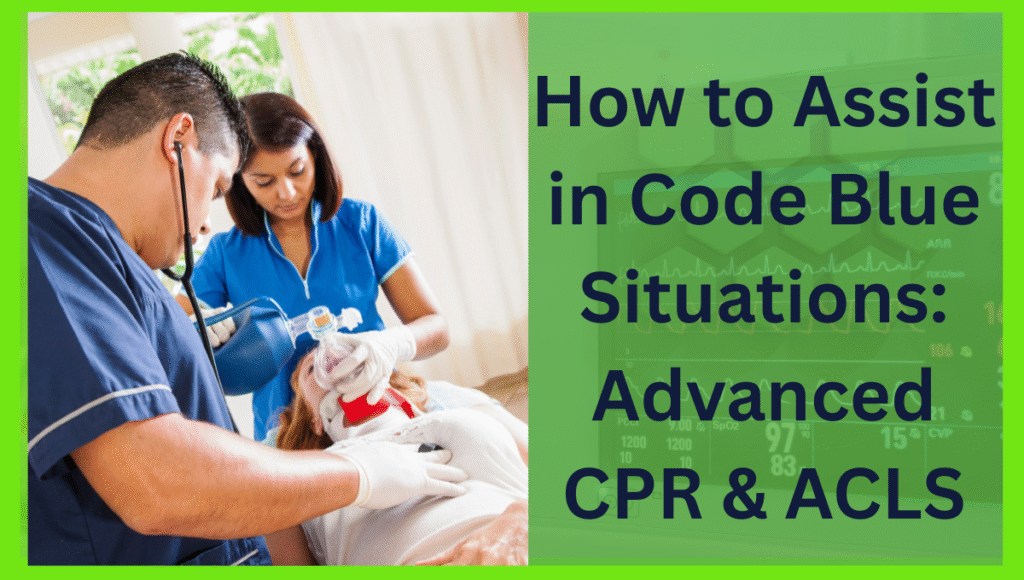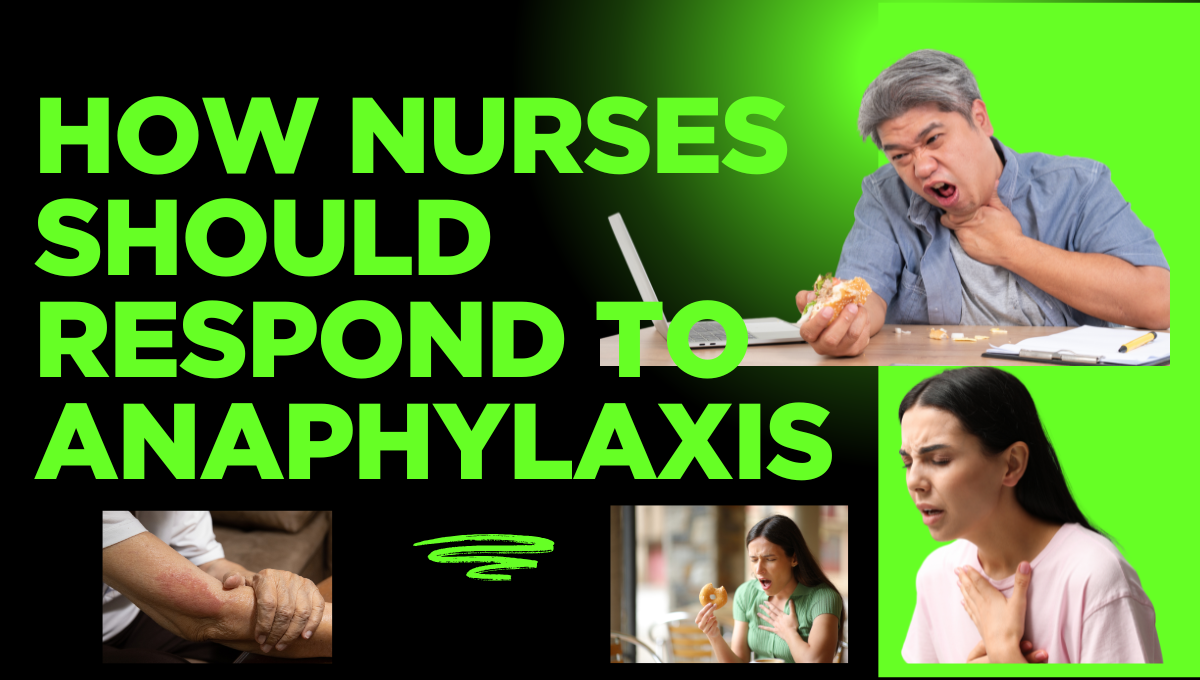How Nurses Should Respond to Anaphylaxis: A Complete Clinical Guide
Overview: The Need for Nurses to Be Ready for Anaphylaxis
One of the most quickly lethal medical situations a nurse may experience is anaphylaxis. It demands quick, expert action, frequently started by the nurse, and doesn’t wait for a doctor. Since nurses are frequently the first responders in clinical settings, their capacity to identify and treat anaphylaxis is vital.
To assist nurses in understanding their duties, actions, and responsibilities during an anaphylactic emergency, this article provides a comprehensive clinical guide.

🧬 What is an allergic reaction? Recognizing the Medical Emergency
A severe, perhaps fatal allergic reaction that affects several organ systems is called anaphylaxis. It can happen minutes after being exposed to an allergen and results in:
Respiratory discomfort and bronchoconstriction
Quick decrease in blood pressure
widespread capillary leakage and vasodilation
Shock and even death if treatment is delayed
IgE antibodies cause a significant release of histamine, which is why it is categorized as a Type I hypersensitivity reaction.
Common Causes of Anaphylaxis in Medical Environments
🛑 Identifying Anaphylaxis Early Signs
A nurse has a higher chance of saving a life if they identify anaphylaxis early. Keep an eye out for:
Signs that are mild to moderate
Warmth or flushing
Hives or an itchy rash
swelling of the tongue, lips, and face
Sneezing or congestion of the nose
Serious and Dangerous Indications
Stridor, wheezing, or trouble breathing
Hypotension or a fast, weak pulse
Cyanosis
Unconsciousness or collapse
Bewilderment or restlessness
Don’t wait for every symptom to show up. The key is early intervention.
The Nurse’s Function in the Management of Emergency Anaphylaxis
Nurses need to be capable of:
Identify symptoms right away.
Give first-line therapy (epinephrine).
Contact the emergency response team.
Support the airway and keep an eye on vital signs.
Inform and comfort the sufferer and their family.
Above all, move fast. Mortality is greatly increased by delayed therapy.
🏥 First nursing actions: Emergency Response Code Activation

1. Immediate Response Protocol
Make an instant call to your facility’s emergency response protocol or a Code Blue. Never attempt to treat severe anaphylaxis by yourself.
- Give 0.3–0.5 mg of epinephrine intramuscularly (IM), usually in the mid-thigh, without delay.
Onset: Prompt bronchodilation and vasoconstriction
Repeat every five to fifteen minutes if the symptoms continue.
The first and most significant medication is epinephrine. If a patient is exhibiting symptoms of anaphylaxis, never wait for orders.
- Verify breathing, circulation, and airway (ABCs)
Remove any blockages from the airway.
Use a non-rebreather mask to deliver oxygen (10–15 L/min).
If the swelling increases, get ready for intubation.
- Place the Patient Suitable
Unless there is acute respiratory trouble, lay the patient flat with their legs raised.
Put the patient in the recovery position if they are unconscious or vomiting.
- Turn on oxygen and keep an eye on your vital signs. Constantly
Use a heart monitor, blood pressure cuff, and pulse oximeter.
Regularly reevaluate because vital indicators can alter quickly.
- Create an IV and Start Fluid Resuscitation
For adults, use a standard saline bolus (20 mL/kg).
To counteract hypotension, get ready for a quick infusion.
- Administer Supplemental Drugs (Steroids, Antihistamines)
25–50 mg intravenously of diphenhydramine (Benadryl)
125 mg IV of hydrocortisone or methylprednisolone
Nebulized albuterol: To relieve bronchospasm
These aid in the patient’s long-term stabilization but do not take the role of epinephrine.
📋 Nursing Care and Monitoring Following Stabilization:
Keep checking vital signs every 15 to 30 minutes.
Keep an eye out for biphasic responses, which occur when symptoms return within a day or 72 hours.
Offer psychiatric assistance because many patients have severe anxiety afterwards.
Move to the intensive care unit if there were significant symptoms.
Following an anaphylactic incident, inform patients about:
Avoiding allergens
How to operate an auto-injector for epinephrine
Donning a medical alert wristband
At the first indication of a recurrence, seeking prompt assistance
If there is a printed emergency action plan, provide it to them.

🖊️ Legal and Documentation Obligations for Nurses Clearly document:
Epinephrine dosage and timing
Vital indicators prior to and following
Every evaluation and intervention
All prescribed drugs
Staff names involved
Response and disposition of the patient
Both the patient and the nurse are legally protected by accurate recording.
🎯 Nurse Simulation Training and Readiness
Simulated scenario training enhances confidence and reaction times. Nurses ought to:
Take part in yearly anaphylaxis exercises.
Examine emergency medication locations and procedures.
Understand how to operate resuscitation equipment and auto-injectors.
The Nurse’s Role in Risk Reduction in Preventing Anaphylaxis in the Future
Upon admission, obtain comprehensive allergy histories.
Indicate allergies explicitly on wristbands and in the EHR.
Verify the ingredients in the drug twice.
When feasible, use equipment devoid of latex.
Work together to update allergy lists with the medical staff.
❓ Common Questions Regarding Nurses’ Management of Anaphylaxis
- Is a doctor’s order required for nurses to administer epinephrine?
Yes, when anaphylaxis is suspected, nurses are permitted to provide epinephrine intramuscularly (IM) without a prior authorization under the majority of emergency protocols. - How soon should someone administer epinephrine?
Right away. The risk of death rises with each minute of delay. - Does anyone ever use IV epinephrine?
Due to the possibility of arrhythmias, only in extreme circumstances and under a doctor’s supervision. - What happens if the patient has an adrenaline allergy?
It is uncommon to have a true allergy. Anaphylaxis is still given because the advantages outweigh the hazards. - Can skin signs be absent from anaphylaxis?
Indeed. Ten to twenty percent of individuals do not develop a rash or hives. Anaphylaxis may be indicated just by hypotension or trouble breathing.

